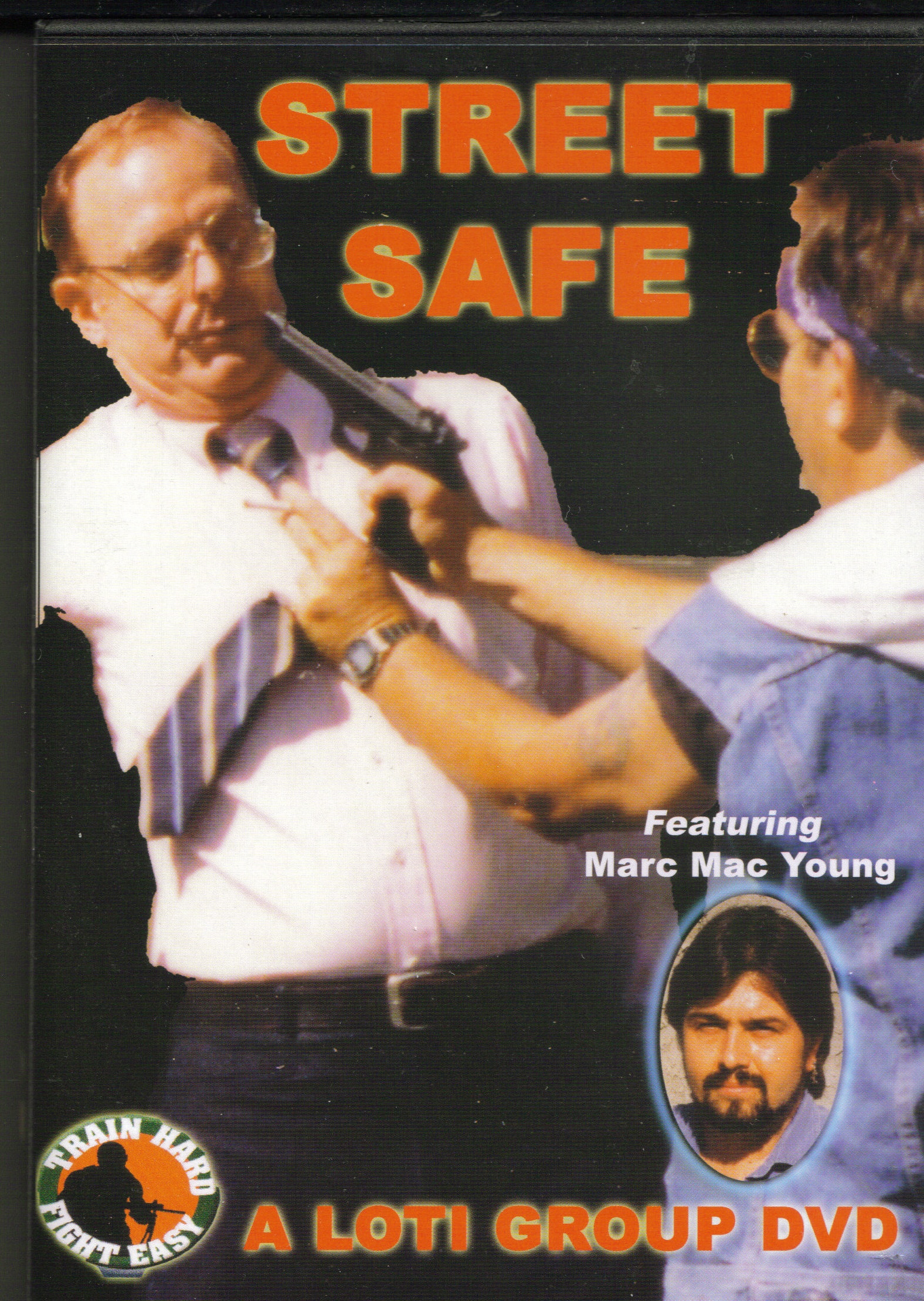Marc MacYoung?
Dianna Gordon MacYoung?
Animal E-list
Crime Avoidance Lectures
Crime Blog
Colorado Classes
Contact Us
FAQs
Hosting A Seminar
Crime Prevention
Expert Witness
Knife Defense
Law Enforcement
Martial Arts
Military
Movie Consulting
Women's Self-Defense
Links
Our Linking Policy
On-line Store
Train with MacYoung
Testimonials
Terms of Use
Topics
of Interest
If you want to make peace,
you don't talk to your friends.
You talk to your enemies.
Moshe Dayan
Kinds of Violence
On this page:
Four Kinds of Violence |
Shifting Kinds Of Violence |
Territorial |
Behavioral |
Criminal |
Predatorial |
When It All Gets Mixed And Mushed
Although it is not popular idea (especially among 'urban warriors,' people obsessed with winning and anyone who wants to believe they can say and do anything without repercussions), the raw truth is: Sometimes you just gotta take your beating like a man.
This becomes especially applicable if you regularly choose to fight. Because, no matter how good you are physically ... you ain't gonna win all the time(1). And the more you step up, the more you'll have to learn how to take a beat down.
OR ... you can look at the social dynamics of a situation and see if there's another way to solve the problem that someone is willing to go violent over.
After a lifetime of engaging in violent conflict, trust me when I tell you the second choice hurts less.
And yet, ever day millions of people manage to find themselves involved in interpersonal violence. Not because the other person attacked, but because they refused to consider the second choice.
Oh BTW, want to know something about preventing violence? MOST violence comes with instructions on how to prevent it! You want power? You want to be safe? Start by learning what can cause a situation to escalate into violence and what YOU can do to either cause or prevent it.
Four Kinds of
Interpersonal Violence
You've heard us talk about our friend Peyton Quinn's
Four Ways to Keep from Being attacked. On that
subject we agree with him whole-heartedly. Another
subject that he talks about is the different kinds of
violence, specifically the difference between
Territorial and Predatorial violence -- and how
important it is to recognize them.
Important in the sense of 'how to avoid violence from occurring.' Basically the difference is one is the person is giving you a choice (e.g. leave or else ...) whereas, predatorial violence is he's coming to get you.
On this summation, we have issues.
Not a problem mind you. It doesn't go that far. Our attitude about this idea isn't that it's wrong. In fact, it's very much dead on in its basic assessment. Our thoughts on this are "That's fundamentally right, but a binary model doesn't exactly cover all the goals of violence." In other words we think it's a little more complex, specifically there aren't two basic kinds, but four fundamental kinds of violence(2).
1) Territorial
2) Behavioral Correction
3) Criminal
4) Predatorial
The reason we make these distinctions is that the
intended goals of these are significantly different.
With these differences come additional factors:
a) whether or not it will become physically violent.
b) what you can do to -- and your chances of -- preventing it
from
going physical.
The first type is the easiest to keep from going physical. As they progress down the list, however, the more difficult they become to either de-escalate or prevent (especially for the average person).
This is critical to realize because as we often say "It is unreasonable to believe that all situations can be resolved reasonably." But the simple truth is while there are situations that -- no matter what you do -- will turn physically violent, MOST situations can be resolved without the use of force.
The trick is not only to be able tell which is which ... but to be able to explain afterwards WHY you did what you did in that situation. Not only will the information on this page save you some beatings, but it can also help keep you out of prison.
Shifting Kinds Of
Violence
While all violence is
based in the fact that the person initiating the
violence (or threatening it) 'wants' something,
the different goals effect how the situation will
manifest. The reason we break they types of
violence into four sections is the nature of what
the person 'wants' changes from situation to
situation -- and can even change in the middle
of a situation.
Having said that, while
that shift from one type to another can happen, it
is usually based on a blend of two things
a) what is going on inside his head given the
circumstances
b) what is going on inside your head and your
actions in the
circumstances.
An example of these points is: While it is true that someone who just offered you territorial violence (leave or else) might decide to follow you on his own, that is a violation of alpha behavior protocols. Him following you for 'no reason' would be an example of point A -- and yes, it does happen. And this is the BIG boogey-man that people use as an excuse NOT to leave.
However, what is far more common is that the person who is offered a choice 'leave or else' cannot keep his mouth shut AS he is leaving (e.g. calling an obscenity over his shoulder). Another common error is the person leaves throwing 'maddawgin' looks over his shoulder. This behavior can -- and often does -- provoke a change from territorial to predatorial violence(3).
But this shows you the importance of point B in the outcome of a situation. That change in the other person's motivation was provoked by what you did..
Understanding what you are dealing with is critical to finding the most effective response to the situation you are facing. And that includes increasing the chances of resolving the situation without having to resort to physical means.
A note on the use of terms and concepts.
For civilians: We have stated elsewhere that
there is a difference between the use of
force and violence, the two are NOT synonymous.
While most physical violence is technically speaking
illegal, what we are talking about here is the
'intent' behind that violence. So we do not identify
all violence as criminal in intent. Recognizing the
differences is vital to avoid victimization,
unnecessary use of force or violence on your part,
then understand that what we are talking about here
are the intended goals of the different kinds of
violence. It's amazing how much violence can be
avoided by simply leaving or apologizing.
For Professionals: In our
de-escalation
program we teach the four
types of violence: Fear, Frenzy, Tantrum and
Criminal (published in
A Professional's Guide To Ending Violence Quickly).
Neither the kinds of violence or types
of violence supersede each other. In fact we look at
the two systems as duel lenses to bring into better
focus the dynamics of any given situation. An easy way
to understand the difference is inward/outward. The
type of violence is the person's motivation (inward
oriented), the kind of violence is the goal/ end
result of the violence (outward oriented). On this page,
we are talking about the goals of different types of
violence.
Territorial:
What does
Territorial Violence look like? And what are you
best strategies to stay safe when confronted with
it?
Behavioral
Correction:
What does violence used to
correct unacceptable behavior look like? Since
this is the most common kind of violence, you might
want to know.
Criminal
What is the difference between the previous types of
violence and
Criminal Violence? The goal of criminal violence
is not you per se, but getting something from you.
Predatorial Violence
Predatorial Violence is the most dangerous
because the person is coming for YOU! It has gone
beyond all the other types of violence and is not
only abusive, but most likely to turn lethal.
When It All Gets Mixed And
Mushed
Human beings are very seldom base their actions on
only one motivation. This is why these basic kinds
of violence can get
mixed and blended.

1)
Anybody who says differently is
Selling something
Lying
Cherry picked the conflicts he/she engaged in (the technical term for this is bullying)
EXTREMELY inexperienced with violence (training and sport fighting are NOT actual violence).
Often all four. People who routinely engage in physical conflict know they can be defeated, hurt or killed. It's only in the fantasy/ obsession/ marketing that appeals to people afraid of violence that the idea of being 'unbeatable' is promoted. In real life, you're going to win some and lose some. Return to Text
2) Now mind you, this has been debated with Peyton over a few bottles of champagne and good natured quarreling. Peyton's position is that the two extra categories are subcategories of the original two. And yes, that model works too. Return to Text
3) There are several factors that combine to cause this shift from territorial to predatorial.
Quite often individuals who are engaging in this behavior are actually betas posing as alphas. As such they are what we call "insecure alphas." This makes them far more touchy and sensitive to challenges (which the described behaviors of the leaving person is).
Another huge factor is survival in the 'streets' is a complex cocktail of status, predation, display and -- not just jockeying for a higher position -- but desperately seeking to keep from losing status. The importance of this cannot be stressed enough. An example of this is, while allowing someone to leave is acceptable (territorial) allowing someone to disrespect you while they are leaving is not. The fear is other predators seeing him allow that will challenge him.
A final -- and again huge -- factor, is while making comments or glaring over your shoulder as you're leaving may be a balm to your pride, it is also common behavior of someone who is going to back away and then return to ambush the person. If that's your plan, it is in his best interest to attack you now.
These are realities that people who insist in getting in the last word do NOT understand. And then they bemoan the fact that they were still attacked. Return to Text


Meditations on Violence
Learn More >
Order Now!

Survivor Personality
Learn More >
Order Now!

Experience- & Reality-Based
Self-Defense
Learn More >
Order Now!

Real World Self-Defense
Learn More >
Order Now!

Do You See What I am Saying?
Reading Body Language
Learn More >
Order Now!

Emotional Survival for Law
Enforcement
Learn More >
Order Now!

Real Fighting
Learn More >
Order Now!

Ending Violence Quickly
Learn More >
Order Now!

Street Safe: How to
Recognize and Avoid Violent Crime
Learn More >
Order Now!
Defeating The Victim's Consciousness
| About navigating this site | Animal List | Bibliography | Bullies | Burglary while on vacation | Classes in Colorado | Car Jacking | Children and Martial Arts | Child Safety | Criminal Mindset | Cults in MA/SD | De-Escalation | E-mail Dianna | E-mail Marc| FAQs | Have MacYoung speak about crime avoidance | Home Page | Home Defense | Hosting a Seminar | Fear | Five Stages of Crime | Knife Fighting | Legal Issues | LEO/Correctional Officer/EMS | Linking policy | Links | Martial Arts | Photo Gallery | Property Crime | Psychology | Rape | Robbery | Safe Dating | Self-Defense Training | Selling your books/DVDs on NNSD | Seminar Schedule | Stalking/Domestic Violence | Street Fighting | Terms of Use | Testimonials | Train with Marc MacYoung | Who is Dianna Gordon MacYoung? | Who is Marc "Animal" MacYoung? | Victimhood | Workplace Problems | Zero Tolerance | ||
| ? 1998-2008 No Nonsense Self-Defense, LLC. All rights reserved. |